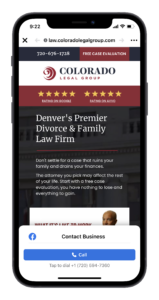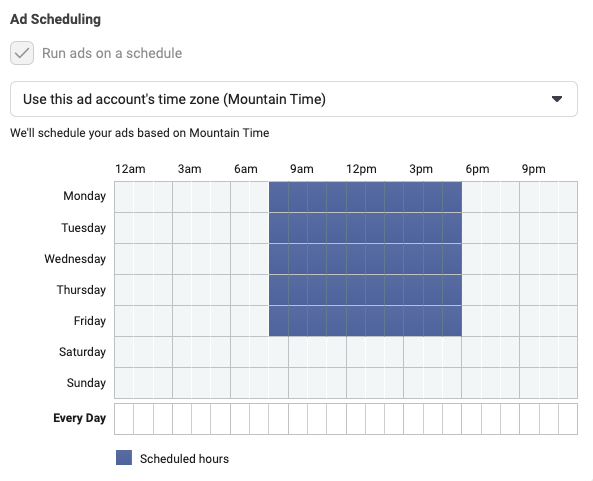How to Get Calls From Facebook Ads for Law Firms
- Brent Harkins
Getting someone on the phone these days can be challenging. With communication preferences trending towards text and email, the value of a phone call to a law firm has risen greatly. It is relatively easy to get a prospect to interact with a webchat for example but the quality of that conversation is generally low. A phone call from a prospective new client (PNC) implies a higher level of intent. They have dedicated time to focus and be actively engaged in a dialogue.
Not only that, but most firms also require scheduling to be done over the phone. That means phone calls are a necessary part of a firm’s sales funnel when getting a PNC to convert from a lead to a consult or client. Because of this many law firms prioritize calls above other conversion metrics within their lead generation and client acquisition strategy. That brings us back to my first point, it’s not easy to get someone on the phone and in most cases, it involves multiple touch points or steps within your marketing and sales journey.
While Google released Local Service Ads (LSAs) to law firms just over a year ago, the verdict is still out when I compare findings with other marketing experts. Yes, LSAs are click-to-call ads where you only pay for calls, yes, they display in the #1 position of search results (before paid search (PPC), local, organic, EVERYTHING!), and yes, you can dispute unqualified leads (to an extent), but in my experience, the negatives outweigh the positives. Starting with the challenge to set up, Local Service Ads do not live in your primary Google Ads account and there is a lengthy approval process. Once your LSAs are live, there is a serious lack of targeting. Not only that, you can not integrate any leads with an external customer relationship management (CRM) platform so a disconnect is created with any existing workflows. That creates the next issue that reporting is practically non-existent and in order to attribute consults or clients, that will need to be done manually which is very time consuming. All of these challenges create an unsustainable campaign that leaves me skeptical of the platform at the time of writing this. Of course, you can set up click-to-call campaigns within Google Ads using call extensions on a call-only ad as an alternative. While a potentially better solution, it has its own challenges as well.
So, with Google clearly putting an emphasis on call generating ads, what has Facebook done as a response?
Facebook Ads Releases Brand New Call Extensions

Facebook recently (September 2021) introduced a new feature to their Conversions and Traffic objective ads. Call Extensions allow advertisers to have a click-to-call call-to-action (CTA) show a call extension (or pop up) on your own website. CTC CTA CE, simple right?
It is actually quite simple. All it takes to execute is a click of a button and addition of your desired phone number and like magic, when a user clicks your ad and visits your landing page, a button will dynamically appear at the bottom of your landing page allowing users to click-to-call your firm. What’s not simple is how to track these calls but we can get into that later.
The Difference Between Facebook Ads Campaign Objectives for Calls
Upon setup, the Campaign Objective is the initial decision point so that’s where your understanding needs to start. Potential confusion is understandable as your primary goal might be the same for all three objectives but the way you achieve it is done through three different campaign types. Let’s get into your Campaign Objective options:
Traffic
Under the consideration stage, the traffic objective is designed to drive people to your website or let them tap to call you. Within the Ad Set, you have two options under traffic to promote calls.
The first is to select Phone Call so that the ad’s CTA is “CALL NOW” and when someone clicks your ad, they’ll directly call your business. This will affect your targeting by instructing Facebook to show your ad to people who are more likely to call you, but the cost is that they will only serve these ads on Facebook so Instagram is not a placement option.
The second option within the ad set traffic is website, which will send users to the webpage of your choosing. Within the ad creative setup, you may then click “Show call extension on your website” and add your phone number. People who click your ad and land on your website will have your number show at the bottom of the screen which they can click-to-call from there. Call extensions only show on the mobile Facebook News Feed. Your ad can still show in other placements, but it won’t include the call extension component.
Lead Generation
Also under the consideration stage, the lead generation objective creates campaigns to find potential customers. The primary use is to gather leads through forms but you can alternatively promote users to call your business. The same ad CTA of “CALL NOW” is used so that a user will be served the ad and immediately prompted to call.
Conversion
The final option lives in the conversion stage and the campaign objective is conversions. To convert phone calls, the event location will be the website. To do so, you will select an appropriate CTA to send traffic to your site and you will show the call extension on the landing page. Note that users have to tap a confirm to call on the call dialer which Facebook reports on so that number may vary from the actual number of people who call your business.
Don’t Miss the Ad Scheduling Step
For all of the Campaign Objectives listed above, there is a critical setting when trying to generate calls. Ad scheduling allows you to select which days and hours your ads will run. Unless you are available 24/7, you should only be running click-to-call ads during hours that you’re available. This setting is within the budget and schedule portion of the ad set. Under the show more options you can then select the days and hours. Note that you must use the lifetime budget option (not daily) to make this available.

We Tested So You Don’t Have To
What Facebook Ad Campaign to Use for Calls
Upon the completion a few key performance indicators stuck out to me. The traffic ads had MUCH higher reach and impressions than lead generation and conversion ads indicating Facebook’s algorithm had a preference to serve those ads. The traffic ads also accounted for 75% of the user engagement. Here is where it gets tricky as mentioned earlier with the reporting providing call confirmation clicks, not necessarily actual calls. It would be my recommendation to use call tracking software like CallRail to use a dedicated number or leverage their Facebook integration.
My Recommendation
Based off my experience, traffic ads to your website with a call extension give you the best chance to generate calls. What happens once you receive that call is totally up to you. US Legal Marketing Group offers social media advertising services to help with your Facebook call ads and consulting services for your sales and operations to create a holistic approach to your client operations efforts. The great thing about working with us is that we do the testing and optimizing on our own law firms so you can Launch and Earn™ these campaigns directly into your own firm. If you have questions or would like to learn more, don’t hesitate to contact us.


